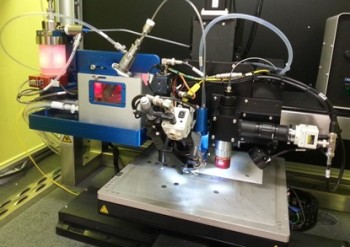
Maintaining jet aircraft is costly and time-consuming, but a new method for printing sensors onto aerospace components could help optimize that process.
Optomec aerosol jet technology has enabled Swansea University researchers to print strain and optical creep sensors directly onto the surface of jet engine compressor blades. Using a laser inspection system and optical light measurement on the sensors, the researchers were able to determine a component’s degree of creep to within 10 nm.
This allows the condition of the blades to be monitored in real time which could lead to increases in fuel efficiency and higher engine running temperatures, according to the researchers at the Welsh Centre for Printing and Coating (WCPC).
The process of printing the sensors begins by using a mist generator to atomize a conductive nano-silver ink. The conductive nano-particles are then refined in a virtual impactor. The resulting material stream is aerodynamically focused using a flow guidance deposition head, which creates an annular flow of sheath gas to collimate the aerosol.
The coaxial flow that exits the flow guidance head through a nozzle directed at the substrate focuses the material stream to a tenth the size of the nozzle orifice (10 µm). Patterning of the material is accomplished by CNC commands that position the flow guidance head while the substrate remains fixed. A five-mm standoff distance between the deposition head and the substrate ensures that the material is deposited accurately on non-planar substrates, over existing structures and into channels.
After the ink has been deposited, a thermal post-treatment gives the sensor the correct conductive and mechanical properties and ensures its adhesion to the substrate. The researchers have also investigated the possibility of locally processing the deposition using a laser treatment process which permits the use of substance materials with very low temperature tolerances. The end result is a high-quality film as fine as 10 nm with a high degree of edge definition and near-bulk properties.
Read more at ENGINEERING.com

